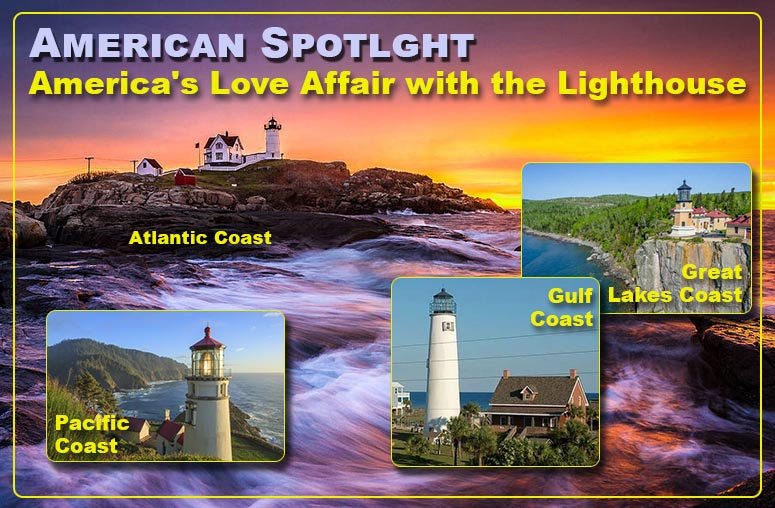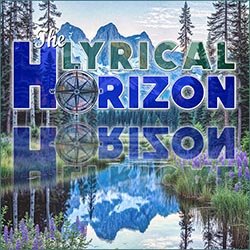
- Atlantic Coast Lighthouses
- New England Lighthouses
- Mid-Atlantic Lighthouses
- Southeast Lighthouses
- Interactive Map
- Gulf Coast Lighthouses
- Interactive Map
- Pacific Coast Lighthouses
- The Northwest
- Northern California
- Southern California
- Interactive Map
- Alaska & Hawaii Lighthouses
- Alaska
- Hawaii
- Interactive Map
- Lighthouses of the Great Lakes Region
- St. Lawrence River, Lake Champlain,
& Hudson River Valley
- Eastern Great Lakes:
Lakes Ontario, Erie, & St. Clair
- Western Great Lakes:
Lakes Huron, Michigan, & Superior
- Interactive Map
- Inland & Replica Lighthouses
- Beacons of the Republic

Historical Origins and Development
America's lighthouse legacy began in 1716 with the construction of Boston Light on Little Brewster Island, the very first lighthouse in what would become the United States. Initially built of wood and later reconstructed in stone, Boston Light marked the beginning of a nationwide effort to secure the growing maritime economy. As colonial ports expanded and international trade flourished, more lighthouses were built along the Eastern Seaboard, lighting the way for whalers, fishermen, merchants, and immigrants seeking safe harbor.
Expansion Across the Nation
With westward expansion and the development of inland waterways and the Pacific coast, the reach of lighthouses extended far beyond the Atlantic. The Great Lakes region, with its treacherous currents and frequent storms, saw a surge in lighthouse construction during the 19th century, while the rugged coastlines of Oregon, Washington, and California demanded towers that could withstand powerful ocean swells. Even remote areas like Alaska, Puerto Rico, and the Gulf of Mexico boast their own distinctive lighthouse designs, adapted to local geography and weather.
Design, Engineering, and Legacy
Lighthouses are marvels of early engineering, built with materials ranging from stone and brick to cast iron and reinforced concrete. Each structure was uniquely suited to its environment, whether perched on sea cliffs, set atop sand dunes, or stationed on offshore reefs. The rotating Fresnel lens revolutionized lighthouse illumination in the 1800s, allowing light to travel farther and brighter than ever before. Many lighthouses were manned by dedicated keepers—often living in isolation—whose steadfast service became legendary. Today, though most lights are automated or decommissioned, the towers remain as iconic landmarks, historical treasures, and cherished symbols of America’s coastal and maritime heritage.
Preservation and Modern Relevance
As maritime technology evolved, many traditional lighthouses were replaced by electronic navigation systems. Yet, public interest in these historic structures has only grown. Numerous nonprofit groups, local governments, and preservationists have stepped in to restore and maintain lighthouses, transforming many into museums, educational centers, or even bed-and-breakfasts. The National Historic Lighthouse Preservation Act of 2000 has helped protect dozens of sites from demolition or neglect. Today, these towers continue to inspire—withstanding time and tide as proud monuments to American ingenuity, community, and the enduring call of the sea.

Lighthouse Superlatives of the United States
Oldest Lighthouse:
Boston Light, Massachusetts (1716)
– The first lighthouse in what would become the U.S., originally built in 1716 and still active today with a resident keeper—the last staffed light in the nation.
Tallest Lighthouse:
Cape Hatteras Light, North Carolina (210 feet)
The tallest brick lighthouse in the U.S., guiding ships past the dangerous Diamond Shoals along the Outer Banks.
Westernmost Lighthouse:
Cape Spencer Light, Alaska
Located at the entrance to Cross Sound, this remote lighthouse sits at the edge of Alaska’s rugged coast, exposed to the Pacific Ocean’s fury.
Southernmost Lighthouse:
Sand Key Light, Florida Keys
Situated just southwest of Key West, this reef light once stood guard in open water—now deactivated, but still recognized as the southernmost traditional structure.
Northernmost Lighthouse (Contiguous U.S.):
Rock of Ages Light, Michigan
Located off Isle Royale in Lake Superior, this lighthouse is often surrounded by ice and stormy weather—marking one of the most remote assignments ever given to keepers.
Most Photographed Lighthouse:
Portland Head Light, Maine
Arguably the most iconic and photographed lighthouse in America, perched dramatically on a rocky bluff near Cape Elizabeth.
Most Isolated Lighthouse:
St. George Reef Light, California
Built on a wave-swept rock six miles offshore from Crescent City, this was one of the most dangerous and difficult lighthouses to construct—and to live in.
Most Haunted Lighthouse:
St. Augustine Light, Florida
Famous for its ghost tours and paranormal reports, this historic light is also a beautifully restored museum on Florida’s Atlantic coast.

Lighthouse Fun Facts
1. George Washington approved the first federal lighthouse.
The Cape Henry Light in Virginia was the first built under the newly formed U.S. government in 1792, commissioned by President George Washington.
2. Lighthouse keepers were often entire families.
Many stations were staffed by married couples and children—everyone had a job to do, especially during storms or emergency rescues.
3. The Fresnel lens changed everything.
Invented in France in 1822, the Fresnel (pronounced "fray-nell") lens allowed light to be seen over 20 miles away using a fraction of the energy.
4. Some lighthouses had to be moved.
In 1999, the Cape Hatteras Lighthouse was relocated 2,900 feet inland to protect it from shoreline erosion a massive engineering feat.
5. Alaska’s Eldred Rock Light is haunted by a shipwreck.
Built after the 1898 wreck of the Clara Nevada, legend has it that mysterious lights and ghostly voices still linger on Eldred Rock.
6. Not all lighthouses are tall.
Shorter lighthouses often sit on high cliffs. For example, California’s Point Reyes Light stands only 35 feet tall but towers over the Pacific from a cliff 300 feet above sea level.
7. There are landlocked lighthouses.
The Great Lakes region has dozens of inland lighthouses along major lakes and rivers. Some, like Marblehead Lighthouse in Ohio, are still active navigational aids.
8. Lighthouse duty could be deadly.
Keepers braved hurricanes, ice storms, isolation, and even deranged visitors. Some died on duty, their stories now part of maritime lore.
9. There’s a lighthouse on a postage stamp.
Actually, many stamps! The USPS has issued several beautiful series of lighthouse stamps honoring these coastal landmarks.
10. You can stay in a lighthouse!
Several former lighthouses are now bed-and-breakfasts or vacation rentals, such as East Brother Light Station in California or Rose Island Light in Rhode Island.

Top 10 Most Beautiful Lighthouses in the United States
Based on Scenery, Architecture, and Photogenic Charm
1. Portland Head Light, Maine
Dramatic rocky coastline, crashing waves, and a classic white tower with red-roofed buildings.
2. Pigeon Point Lighthouse, California
Towering over the Pacific with flower-covered bluffs, it’s one of the tallest on the West Coast.
3. Heceta Head Light, Oregon
Nestled into a forested hillside with a panoramic view of the Pacific, it's a Pacific Northwest treasure.
4. Split Rock Lighthouse, Minnesota
Perched on a sheer cliff above Lake Superior, this lighthouse is stunning in all seasons' especially autumn.
5. Bass Harbor Head Light, Maine (Acadia National Park)
A compact lighthouse on pink granite cliffs, frequently photographed at sunset.
6. Point Reyes Lighthouse, California
Accessed by a dramatic 300-step staircase, with epic ocean views and frequent whale sightings.
7. St. Augustine Lighthouse, Florida
Striped in black and white with red trim, surrounded by Spanish moss and maritime history.
8. Big Sable Point Lighthouse, Michigan
A striking black-and-white tower rising from remote Lake Michigan dunes, accessible by foot through a forested trail.
9. Tybee Island Light, Georgia
Towering near Savannah, with bold black-and-white striping and wide beach views.
10. Diamond Head Lighthouse, Hawaii
A postcard-perfect white tower beneath the volcanic ridge of Diamond Head on Oahu’s southern shore.








